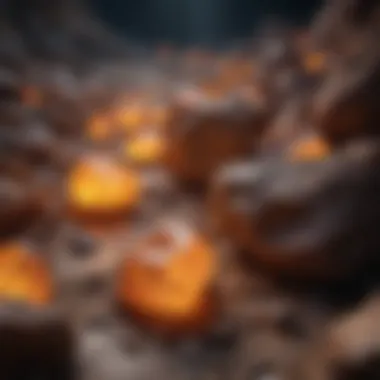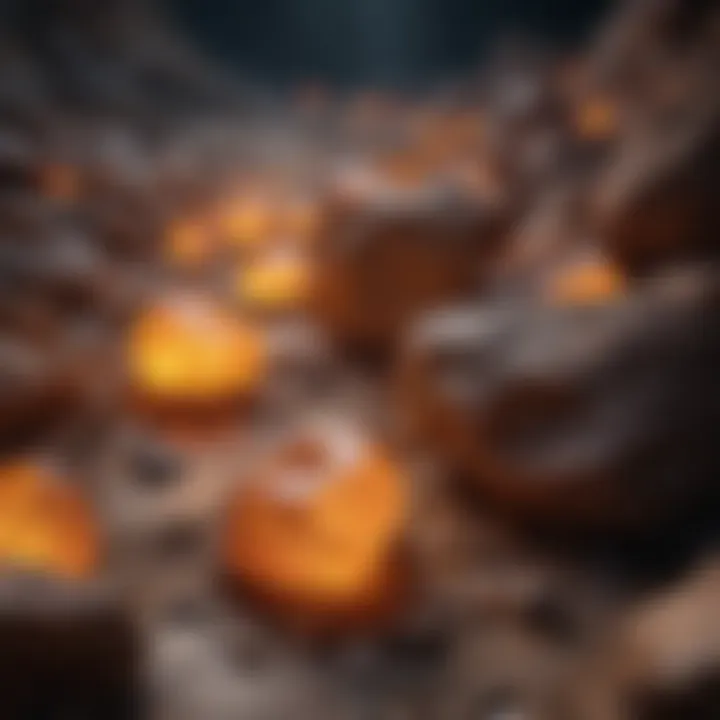Natural Glow in the Dark Stones: Properties and Uses


Intro
Natural glow in the dark stones serve as a fascinating intersection between nature and science, revealing the underlying beauty of our planet. This article aims to take a closer look at these unique geological specimens, shedding light on their properties, how they were formed, and the different ways they can be used. We will explore why so many collectors are drawn to these captivating stones, the science behind their luminescence, and how they can add a unique flair to art, jewelry, and home decor.
Understanding the core attributes of these stones not only prepares the ground for appreciating their beauty but also helps in recognizing their significance in the broader context of geology and collectible items. This guide is tailored for enthusiasts and scholars alike, aiming to provide insights into the meticulous world of rock and fossil collection.
Featured Collectible of the Month
Overview
One stone that catches the eye each month is the Wulfenite. Known for its striking yellow and orange hues, Wulfenite is also lauded for its unique ability to emit a gentle glow in the dark after being charged by a light source. This mineral, primarily found in the Ozark Mountains, has become a highlight among collectors. Its vibrant colors and luminescent properties make it an exemplary specimen for both display and study.
Historical Significance
The historical roots of Wulfenite can be traced back to its first discovery in the mid-1800s. Initially esteemed for its lead content, it later garnered attention for its beauty and rarity. Wulfenite, named after the Austrian mineralogist Franz Xaver von Wulfen, has been a coveted item among mineral collectors ever since. Particularly notable is its role in the development of mining during the 19th century, where it often played a part in various silver-lead mines. Its glow, often described as ethereal, evokes the same wonder in modern collectors that it did in the previous centuries.
"There’s a certain magic in how Wulfenite captures light, almost as if it's holding a piece of sunshine within its yellow depths."
Identification Techniques
Visual Characteristics
Identifying natural glow in the dark stones involves several key visual cues. For Wulfenite, collectors should look for the following:
- Color: Typically bright yellows to deep oranges
- Luster: Resinous to sub-metallic sheen
- Crystal Form: Commonly appears in tabular, prismatic forms
- Fluorescence: Will glow a soft yellow-orange under UV light
When examining any glow-in-the-dark stone, also keep an eye out for any inclusions or unusual patterns that can indicate authenticity and origin.
Resources for Identification
For collectors seeking to delve deeper into identification, there are various resources available:
- Books: "The Audubon Society Field Guide to North American Rocks and Minerals" contains excellent visual references.
- Websites: Enriched resources can be found at Wikipedia for geological traits and Britannica for historical context.
- Communities: Engaging in forums such as Reddit can provide real-time insights from experienced collectors and enthusiasts.
Understanding these techniques not only enhances the appreciation of natural glow in the dark stones but also empowers collectors to make informed decisions in their pursuits.
Understanding Natural Glow in the Dark Stones
Natural glow in the dark stones capture the imagination of enthusiasts and scientists alike. These unique minerals not only possess aesthetic value but also serve as a bridge between the realms of science, geology, and art. Understanding these stones reveals the fascinating interplay of natural processes and the inherent beauty of our planet's materials. With a growing interest in sustainable practices and eco-friendly collectibles, the spotlight on these natural wonders is brighter than ever.
Definition and Characteristics
Glow in the dark stones are minerals that exhibit luminescent properties, which means they can emit light after absorbing energy from various sources. The characteristics of these stones can vary widely based on their mineral composition, the conditions of their formation, and their exposure to light. A few defining traits include:
- Color and Appearance: Many glow stones exhibit a striking color palette, often seen as greens, blues, and purples when illuminated. Some even show fascinating patterns or textures that enhance their visual appeal.
- Luminescence Duration: The duration and intensity of luminescence depend on the mineral type and its properties. Some stones might glow brightly but for a short time, while others can shine steadily for hours after exposure to light.
- Environmental Resilience: Several natural glow stones are surprisingly durable. Their robustness makes them suitable for various applications, including art and landscaping.
In appreciating these stones, one gains insight into their geological history and the unique conditions required for their formation.
Scientific Principles of Luminescence
Understanding the scientific principles behind luminescence is crucial to fully grasp the allure of glow in the dark stones. Three main types of luminescence contribute to this phenomenon: photoluminescence, chemiluminescence, and the photophysics associated with these stones.
Photoluminescence
Photoluminescence is a process where materials absorb photons and re-emit them as light. This is perhaps the most common form of luminescence discussing glow in the dark stones. One key characteristic of photoluminescence is its dependence on external light sources—usually ultraviolet (UV) light. Stones exhibiting this property store energy during exposure and release it gradually, causing them to luminesce in the dark.
A significant advantage of photoluminescence is its prevalence in various minerals, making it easily accessible for collectors. However, the effects may diminish over time, which raises concerns about longevity in certain applications, especially decorative ones.
Chemiluminescence
Chemiluminescence is a distinct type where light is produced through chemical reactions, often seen in bioluminescent organisms like fireflies. While less common in minerals, some glow stones rely on this principle to emit light. A key characteristic of chemiluminescence is its ability to glow without an external light source, making it a captivating phenomenon in places where no light is available.


One unique feature of chemiluminescence could be its duration of glow. Some stones may emit light for an extensive time without fading, providing a striking display under natural conditions. However, the rarity of such stones limits their accessibility to collectors.
Photophysics in Glow Stones
Exploring photophysics in glow stones is essential to understanding how light interacts with different materials. This domain focuses on the absorption and emission of light within these minerals. A notable characteristic of this aspect is the efficiency of the energy transfer between excited states and how it influences the quality of luminescence.
The advantage of understanding photophysics lies in enhancements in practical applications, such as improving the glow quality in art installations or jewelry. It paves the way for innovations in how these stones can be utilized in various fields. However, the complex nature of these interactions may be challenging for novice collectors to grasp, possibly hindering informed decisions.
Geological Origins of Glow Stones
Understanding the geological origins of glow stones is crucial to appreciating their unique qualities and how these minerals interact with light. The formation processes, environmental conditions, and the geological timeline play a significant role in how these minerals develop their luminescence. This section aims to demystify the components, conditions, and locations that give birth to these fascinating stones, shedding light on their journey from the Earth's depths to collectors' hands.
Formation Processes
Mineral Composition
Mineral composition is a key element in the story of glow stones. Different minerals, such as calcite, fluorite, and barite, contribute various characteristics to glow stones. Each mineral has its own unique properties, which are responsible for the intensity and type of luminescence exhibited. The chemical structure and the presence of impurities or activators govern how effectively these stones can absorb light and re-emit it later.
For instance, fluorite can exhibit bright fluorescence under UV light, making it a sought-after choice among collectors. This makes it a popular mineral for those interested in luminescent geology due to its vibrant glow and relative accessibility. However, it can be sensitive to environmental changes, making handling and preservation crucial for maintaining its luminescence over time.
Environmental Factors
When examining environmental factors, we must consider how location affects the luminescence of glow stones. Factors including light exposure during their formation, pressure, and temperature can significantly alter their properties. For example, stones formed in a high-pressure environment may develop different crystal structures compared to those formed near the surface.
The unique feature of varying geological environments means that even similar minerals can exhibit distinct glowing qualities based on their origins. This variability can enhance their appeal in the collecting community, allowing enthusiasts to study and appreciate the differences among specimens from different geographical areas. On the downside, these specific conditions can make some stones rare and hard to find in the market.
Time and Geological Activity
Time and geological activity also play pivotal roles in the development of glow stones. Over thousands, if not millions of years, tectonic movements and volcanic activity contribute to the formation of unique mineral deposits. The slow, painstaking processes of erosion and mineralization can lead to the birth of luminescent stones that sparkle with history.
The geological timeline is particularly interesting because it captures the history of the Earth itself. Some glow stones can only be found in locations that have witnessed significant geological activity, making them a coveted find among collectors who value the stories behind their specimens. However, extracting these stones responsibly requires careful consideration of the environmental impact and sustainability of mining practices.
Notable Locations
Global Regions of Interest
When diving into the global regions of interest, it becomes clear that specific locales are renowned for their abundance of glow stones. For example, areas like the Appalachian Mountains or regions in Nigeria and Mexico are known hotspots for finding vibrant luminescent minerals. Each location features various mineral compositions that contribute to the distinct properties of the stones found there.
These regions are not just beneficial for the diversity of specimens available but also provide normal conditions for geology enthusiasts to explore and understand the relationship between the Earth’s geology and luminescence. However, being a collector means also grappling with the challenges posed by legal restrictions and the need for ethical sourcing practices.
Specific Sites Known for Luminescent Minerals
Numerous specific sites known for luminescent minerals offer fans of geology a chance to find rare gems. Places like the Cave of the Crystals in Mexico or the Franklin Mineral Museum in New Jersey are treasure troves for collectors. These locales present an exceptional opportunity to study glow stones in their natural habitat, as well as to learn about the processes used to extract and preserve them.
What's appealing about these specific sites is their dual role as both scientific study grounds and adventure spots for collectors. However, challenges persist, such as the delicate balance between tourism and the conservation of local geology. Visitors should tread lightly, always being mindful of the environmental impact of their explorations.
"Geology gives us a window into Earth's history; 'glow stones' spark a light into that very past."
In summary, the geological origins of glow stones offer valuable insight not only into their composition and luminescent qualities but also into the ecological and historical factors at play in their formation. Understanding these aspects enriches the appreciation for these natural wonders and their further applications in various domains, from art to architecture.
Types of Natural Glow in the Dark Stones
Understanding the variety of natural glow in the dark stones is essential to grasping their significance in both geological study and collectible interests. Each category possesses unique qualities and implications that not only fascinate enthusiasts but also drive innovations in various fields. By categorizing glow stones into types, collectors can focus their efforts more effectively, whether in acquiring specimens or delving into their applications. Moreover, recognizing the distinct properties of each type informs methods for preservation, exhibition, and educational use, making the topic not just important but indispensable for serious collectors.
Fluorescent Minerals
Fluorescent minerals are like the life of the party when it comes to glow stones. They glow under ultraviolet light, often exhibiting dazzling colors that transform their appearance. Common examples include calcite, scheelite, and fluorite. These stones absorb UV light and then re-emit it almost instantaneously in visible wavelengths, which can be quite the spectacle.
Collectors often seek out fluorescent minerals for their vibrant displays. When you’re out hunting for these, check out local mines or areas known for their UV-responsive minerals. What's fascinating is how the intensity of the fluorescence can change based on mineral impurities and the specific wavelengths of light enclosed in the stone. This variability can result in a diverse collection that pops with color and allure.
Phosphorescent Stones
In contrast, phosphorescent stones take longer to fade away after the light source is removed, akin to having a glow-in-the-dark sticker on your wall. When these minerals are charged, they store energy and release it slowly, emitting light for seconds to minutes. Zinc sulfide and strontium aluminate are among the most commonly known phosphorescent materials, each offering an impressive afterglow that can last well into the night.


Collectors admire phosphorescent stones for their lingering light show. You can typically find them in decorative uses or in scientific demonstrations to show how minerals behave differently under varying light conditions. When sourcing these, consider the storage — proper dark conditions can help maintain their luminescent properties, ensuring they stay fresh and bright between showings.
Radioactive Luminescence
Then there’s the more uncommon category of radioactive luminescence. Much like the flickering glow of a distant star, these stones contain trace amounts of radioactive elements which enable them to emit light. Examples include autunite and torbernite, minerals that harness radioactivity to produce a glow.
While grabbing these specimens can be both intriguing and eye-catching, it's crucial to handle them with care. Due to their radioactive nature, collectors should be aware of safety protocols to ensure they are not exposing themselves to harmful levels of radiation. Depending on your local regulations, you might also need special documentation for exchange or display purposes.
Remember: Always check for authenticity and safety when collecting. Knowing the background of your stones will enhance appreciation and understanding for any educational conversations you might have.
By exploring the types of natural glow in the dark stones, collectors not only widen their knowledge horizon but also augment their skill set for identifying authentic specimens and engaging with the geological wonders that nature presents.
Applications of Glow in the Dark Stones
The applications of glow in the dark stones are as fascinating as the stones themselves. Their unique luminescent properties not only mesmerize collectors but also serve practical purposes in various fields. From art to architecture, these stones blend aesthetics with functionality, creating a niche that attracts both artisans and professional users alike.
Artistic Uses
Decorative Items
Glow in the dark stones serve as enchanting decorative items that can elevate any space. One of the key characteristics of these items is their ability to bring a bit of magic into everyday life. When the lights dim, these stones transform; they radiate gentle illumination, creating a tranquil ambiance.
Such items include lamp bases, coasters, and even wall art that take advantage of the stones’ glow. The unique feature of using natural glow stones in interior decor lies in their natural origins, often telling a story of geological history and evolution. Their appeal primarily lies in their eco-friendliness, as they derive from naturally occurring minerals rather than synthetic materials. However, one must consider that not all glow stones provide equal luminosity or duration of glow, requiring careful selection for specific projects.
Sculptures and Installations
Sculptures and installations made from glow in the dark stones combine artistry with innovative design. The captivating nature of these pieces ensures they stand out in any setting. Artists often use these stones to convey themes of nature, light, and time, engaging viewers in a dialogue about the interconnectedness of the universe.
A significant characteristic of such sculptures is their dynamic interaction with various light sources. They often morph both under daylight and artificial light, presenting varying hues and intensities of glow during nightfall. Unique installations in public spaces or galleries serve to attract attention, while also offering an element of surprise. One downside of using these stones is their sometimes hefty price tag, which can deter budget-conscious artists or venues.
Jewelry and Ornamentation
Crafting Techniques
The crafting of jewelry involves various techniques that can be enhanced by the use of glow in the dark stones. Whether it's wire wrapping, bead weaving, or resin casting, each method allows for the incorporation of these luminous gems into wearable art. The key characteristic of crafting glow stones into jewelry is the creativity it invites; artists are able to experiment with colors and forms that speak to their own unique styles.
A standout unique feature of these techniques lies in their versatility. They can be combined with both contemporary metals and traditional materials, appealing to a diverse audience. However, it's important to note that crafting can require specialized skills and tools, potentially presenting a barrier for beginners.
Market Trends in Glow Jewelry
Market trends in glow jewelry indicate a growing appetite among consumers. The key characteristic driving this trend is the blend of spirituality and aesthetics, as many wearers are drawn to the symbolism of light in darkness. The unique aspect of glow jewelry is that it often serves as a conversation starter, inviting questions about the materials and techniques involved.
Despite its appeal, one must consider the fluctuating prices influenced by rarity. As glow stones become more sought after, the market may see a rise in competition among collectors and artisans alike.
Architectural Applications
Use in Landscape Design
Glow in the dark stones play a significant role in landscape design, adding visual intrigue and functionality to outdoor spaces. The ability to absorb sunlight or artificial light and emit it later makes these stones ideal for pathways, gardens, and water features. One of the most valuable aspects of using these stones in landscape design is their aesthetic quality; they can transform an ordinary garden into a magical realm at night.
In addition, these stones can also aid in safety by illuminating pathways without the need for electricity, making them an environmentally-friendly choice. However, considerations must be made regarding placement and the longevity of glow, as some stones may require more direct sun exposure than others to effective function.
Functional Use in Safety Signage
The functional use of glow in the dark stones in safety signage is another remarkable application worthy of attention. These stones can be integrated into existing signage to enhance visibility in low-light situations. The key feature here is their ability to shine brightly in the darkness, making them invaluable in emergency situations where conventional lighting may fail.
One unique advantage of using glow stones for safety signage is their low maintenance and reliability. Unlike electrified solutions, they don’t require power lines or batteries, which means they can operate independently. On the downside, care should be taken when placing these stones to ensure they are not obstructed and can fully charge during the day.
Collecting Glow in the Dark Stones
Collecting natural glow in the dark stones presents an enticing opportunity for enthusiasts and scholars alike. This endeavor not only enriches one’s personal collection but also fosters a deeper understanding of geological wonders. Collectors can appreciate the intricate characteristics and diverse origins of these stones, ultimately paving the way for responsible collection methods and sustainable practices. Moreover, the advent of glow stones has invigorated interest in both geology and mineralogy, often turning casual enthusiasts into dedicated collectors.


Identifying Authentic Specimens
Testing for Luminescence
When it comes to testing for luminescence, this crucial procedure helps collectors distinguish genuine glow stones from glass or synthetic alternatives. Luminescence tests generally involve exposing the stones to UV light or a strong source of illumination. A genuine glow stone will exhibit a vibrant afterglow; its brilliance reveals the mineral’s authenticity. This feature is particularly appealing, as luminescence can vary widely among minerals, making it a captivating spectacle.
However, some drawbacks exist. Not all glow stones are equally luminous, which means that a less bright sample can often mislead an untrained eye. Moreover, understanding how different minerals react to light requires some level of expertise. This aspect purifies the authentic collector from mere casual observers who might not pay enough attention to subtle differences.
Distinguishing Real from Artificial
Moving on to distinguishing real from artificial stones, several identifiers exist to guide collectors in this area. This part of the collection process is crucial; artificial imitators may look similar but lack the natural qualities that make authentic stones so valuable. Notably, the use of a magnifying glass or jewelers loupe can reveal inconsistencies, such as air bubbles trapped in glass impostors.
Among the distinguishing features, weight can also play a role—genuine glow stones often feel weightier compared to their artificial counterparts. This depth is beneficial because it adds another layer of confidence in verifying the authenticity. Nevertheless, collectors must be cautious. Misidentifications can happen, leading to potential disappointments. Knowledge and keen observation skills are vital here.
Preservation Techniques
Best Practices for Storing Collectibles
Once genuine specimens are acquired, proper storage becomes a key concern. Best practices for storing collectibles should always be prioritized. Storing these stones in a cool, dry environment, away from direct sunlight, is paramount. Adding silica gel packets or using airtight containers can significantly reduce moisture levels, which helps prevent unwanted reactions or degradation of the stones. This understanding nurtures the longevity of a collection.
Furthermore, using padded containers helps mitigate the risk of scratches or chipping, ensuring the stones remain in prime condition. These methods highlight the importance of protecting one’s investment and appreciation for these unique geological pieces.
Handling and Cleaning Guidelines
Lastly, handling and cleaning glow stones requires a certain level of gentleness. Using soft cloths to wipe off dust prevents scratches. Additionally, avoiding harsh chemicals is critical, as they can often degrade the natural surface of the stones. A mild soap solution with warm water works wonders for cleaning, enhancing their visual appeal without compromising integrity.
It is worth noting that careful handling extends beyond merely examining the stones. Employing gloves while touching particularly valuable or delicate specimens can avert potential damage from oils and dirt on fingers. Thus, creating positive habits around handling and cleaning is of utmost importance for every serious collector.
The Future of Glow in the Dark Stones
The exploration of natural glow in the dark stones is not just a journey through enchanting geological phenomena, but also a compass pointing towards the future of mineral discovery and sustainability. As humanity increasingly looks towards innovative ways to integrate natural resources into modern applications, the significance of glow in the dark stones is rising steadily. By understanding their potential, collectors and enthusiasts can navigate the evolving landscape of geology, art, and sustainable practices.
Innovations in Mineral Discovery
Emerging Technologies
Emerging technologies are reshaping the way we discover and analyze minerals, offering tools previously deemed improbable. For instance, advancements in imaging techniques like hyperspectral imaging allow mineralogists to examine the spectral signatures of materials, revealing their luminescent properties without the need for extensive physical sampling. This non-invasive approach is crucial in preserving specimens and exploring untouched locations.
A key characteristic of these technologies is their adaptability. Many of them can be used in various environments, whether in the field or in local laboratories. This flexibility makes them an increasingly popular choice among researchers, allowing rapid data gathering in diverse geological settings.
The unique feature of these innovations lies in their ability to enhance accuracy and efficiency. By utilizing drones equipped with advanced sensors, for instance, geologists can survey large expanses of land quickly and comprehensively. The advantages here are substantial, enabling a more thorough understanding of mineral distribution patterns and, consequently, the identification of promising glow stone deposits. However, a disadvantage might just be the cost associated with implementing these technologies, which can be prohibitive for smaller collecting groups.
Potential New Applications
The potential new applications of glow in the dark minerals are as varied as they are surprising, suggesting their use could transcend the realms of art and decoration. One can envision applications ranging from unique lighting solutions to innovative safety features in architecture. The properties of specific glow in the dark stones might suit creating energy-efficient lighting designs, illuminating pathways without the need for traditional power sources.
This versatility is a hallmark of glow stones and their potential for integration into everyday materials. For example, incorporating phosphorescent minerals into concrete could pave the way for roads that glow at night, enhancing safety. Their unique qualities present a wealth of opportunities sufficient enough to stimulate interest among manufacturers and designers alike.
The primary advantage of these applications is their capability to marry aesthetics with functionality, which is gaining traction in a world ever focusing on sustainability and energy efficiency. On the flip side, a common concern involves the lifecycle impact of producing such materials. Enthusiasts and professionals must also ponder whether the extraction processes can align with environmentally friendly practices.
Sustainable Practices in Collecting
Ethical Sourcing
Ethical sourcing has become an integral component in the collecting community. As the demand for glow in the dark stones grows, so does the necessity for responsible extraction. Ethical sourcing ensures that these minerals are obtained in a manner that respects both the environment and local communities. This means working with suppliers who adhere to sustainable mining practices and advocate for the fair treatment of those involved in the mining process.
The hallmark of ethical sourcing is transparency. Collectors increasingly favor suppliers who provide detailed information on the origins of their specimens. This not only helps ensure that no harmful extraction methods are used but also supports communities economically. In addition, sourcing in this manner can contribute to maintaining the delicate balance of ecosystems where these stones are found.
However, a challenge in ethical sourcing revolves around verifying claims made by suppliers. As the market grows, distinguishing between authentic ethical claims and vague marketing promises can become nuanced. Collectors need to remain vigilant and informed to ensure their choices align with their values.
Environmental Considerations
Environmental considerations must weigh strongly in the future of collecting glow in the dark stones. A focus on minimizing environmental impact guides current practices in not just the extraction of, but also the eventual use of these minerals. The impact of mining can be significant and long-lasting, necessitating ongoing assessment and adaptation to best practices.
Highlighting the impact of efficient, low-impact mining processes stands at the forefront of the effort to protect sensitive ecosystems. One example is the use of methods that require less water or energy, thereby reducing the overall ecological footprint. Such approaches mark a beneficial choice for collectors wishing to engage with their passion responsibly.
Furthermore, implementing reclamation practices after mining operations conclude is another vital aspect. These efforts help restore mined landscapes and support biodiversity, ensuring that the land can continue to thrive. Collectors and enthusiasts who are conscious of environmental considerations will find increased advocacy for sustainable practices that can protect both their passion and the planet.
In summary, embracing the future of glow in the dark stones means aligning with innovations in discovery and sustainable practices in a manner that respects both the remarkable geological properties and the environments from which these stones come. The future, therefore, appears dazzling, with promising avenues to explore.



